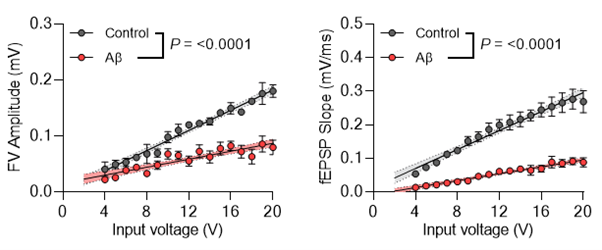The store will not work correctly when cookies are disabled.
JavaScript seems to be disabled in your browser. For the best experience on our site, be sure to turn on Javascript in your browser.
Images β-Amyloid Peptide (1-42) (human) (HB9805) testing Acute hippocampal slice (n = 4 Wistar rats, post-natal day 25-30).
3hrs exposure to 2µM amyloid-beta.
Field excitatory post-synaptic potential (fEPSP) recordings.
Stimulating CA3/Schaffer Collaterals; recording from CA1 field.
(left) Evoked fibre volley (FV) amplitude as a function of stimulation magnitude.
(right) Evoked fEPSP slope as a function of stimulation magnitude.
Analysis by simple linear regression.
β-Amyloid Peptide (1-42) (human) (HB9805) testing Acute hippocampal slice (n = 4 Wistar rats, post-natal day 25-30).
3hrs exposure to 2µM amyloid-beta.
Field excitatory post-synaptic potential (fEPSP) recordings.
Stimulating CA3/Schaffer Collaterals; recording from CA1 field.
(left) Evoked fibre volley (FV) amplitude as a function of stimulation magnitude.
(right) Evoked fEPSP slope as a function of stimulation magnitude.
Analysis by simple linear regression.
Solubility & Handling Storage instructions -20°C
Solubility overview Soluble in 1.0% NH4 OH
Handling Please note that this product is supplied as a lyophilized solid and may be very hard to visualize.
Amyloid beta peptides are prone to aggregation and as such, there are a variety of published methods for handling them.
For reconstitution to use as monomers
We recommend using NH4 OH with this product - you should use 1.0% NH4 OH as the solvent followed by buffer (for example 1x PBS).
Add 1.0% NH4 OH directly to the lyophilized peptide (~70-80 μl for 1mg of peptide). Do not store the peptide in 1.0% NH4 OH.
Immediately dilute your solution to a concentration of ~1mg/mL or less in your buffer (e.g 1x PBS, water or an alternative buffer).
Vortex gently to mix (less than 1 minute).
Note: This method may not completely remove pre-aggregates. Vortexing may encourage seeding and further aggregation of the peptide.
For reconstitution for oligermization: We recommend dissolving to 5mM in DMSO. Please see our Amyloid Beta Protocol for more information.
Shipping Conditions Stable for ambient temperature shipping. Follow storage instructions on receipt.
Important This product is for RESEARCH USE ONLY and is not intended for therapeutic or diagnostic use. Not for human or veterinary use
Chemical Data Chemical name DAEFRHDSGYEVHHQKLVFFAEDVGSNKGAIIGLMVGGVVIA
Chemical structure
Molecular Formula C203 H311 N55 O60 S
Sequence (one letter) DAEFRHDSGYEVHHQKLVFFAEDVGSNKGAIIGLMVGGVVIA
PubChem identifier 71773143
SMILES CC[C@H](C)[C@@H](C(=O)N[C@@H]([C@@H](C)CC)C(=O)NCC(=O)N[C@@H](CC(C)C)C(=O)N[C@@H](CCSC)C(=O)N[C@@H](C(C)C)C(=O)NCC(=O)NCC(=O)N[C@@H](C(C)C)C(=O)N[C@@H](C(C)C)C(=O)N[C@@H]([C@@H](C)CC)C(=O)N[C@@H](C)C(=O)O)NC(=O)[C@H](C)NC(=O)CNC(=O)[C@H](CCCCN)NC(=O)[C@H](CC(=O)N)NC(=O)[C@H](CO)NC(=O)CNC(=O)[C@H](C(C)C)NC(=O)[C@H](CC(=O)O)NC(=O)[C@H](CCC(=O)O)NC(=O)[C@H](C)NC(=O)[C@H](CC1=CC=CC=C1)NC(=O)[C@H](CC2=CC=CC=C2)NC(=O)[C@H](C(C)C)NC(=O)[C@H](CC(C)C)NC(=O)[C@H](CCCCN)NC(=O)[C@H](CCC(=O)N)NC(=O)[C@H](CC3C=NC=N3)NC(=O)[C@H](CC4C=NC=N4)NC(=O)[C@H](C(C)C)NC(=O)[C@H](CCC(=O)O)NC(=O)[C@H](CC5=CC=C(C=C5)O)NC(=O)CNC(=O)[C@H](CO)NC(=O)[C@H](CC(=O)O)NC(=O)[C@H](CC6C=NC=N6)NC(=O)[C@H](CCCNC(=N)N)NC(=O)[C@H](CC7=CC=CC=C7)NC(=O)[C@H](CCC(=O)O)NC(=O)[C@H](C)NC(=O)[C@H](CC(=O)O)N
Structure image
InChiKey XPESWQNHKICWDY-QYFPAAMGSA-N
Appearance Lyophilized White solid
References for β-Amyloid Peptide (1-42) (human) References are publications that support the biological activity of the product
Amyloid-peptide β 42 Enhances the Oligomerization and Neurotoxicity of apoE4: The C-terminal Residues Leu279, Lys282 and Gln284 Modulate the Structural and Functional Properties of apoE4 Dafnis I et al (2018) Neuroscience 394 : 144-155 β-Amyloid: the key peptide in the pathogenesis of Alzheimer's disease Sun X et al (2015) Front Pharmacol 6 : 221
Publications
These publications cite the use of β-Amyloid Peptide (1-42) (human) purchased from Hello Bio:
The Alzheimer risk factor CD2AP causes dysfunction of the brain vascular network Vandal et al (2022) bioRxiv PubMedID: https://www.biorxiv.org/content/
Study of the potential neuroprotective effect of Dunaliella salina extract in SH-SY5Y cell model Gallego et al (2021) Anal Bioanal Chem . : doi: 10.1007/s00216-021-03819-1. In vitro Neuroprotective Potential and Lipidomics Study of Olive Leaves Extracts Enriched in TriterpenoidsGallego R et al (2021) Front Nutr 8 : 769218
Tell us about your publication! What Hello Bio product(s) have you cited?
Captcha Please type the letters and numbers below Submit
β-Amyloid (1-42) protein fragment. Implicated in Alzheimer's disease.
![Amyloid beta (1-42) (human) TFA | [107761-42-2] Amyloid beta (1-42) (human) TFA | [107761-42-2] Chemical Structure](https://cdn.hellobio.com/media/catalog/product//h/b/hb4988_1.png)
![Amyloid beta (1-42) (human) TFA | [107761-42-2] Amyloid beta (1-42) (human) TFA | [107761-42-2] Chemical Structure](https://cdn.hellobio.com/media/catalog/product//h/b/hb9805_p05067_1iyt__beta_-amyloid_peptide__1-42___human__1.png)






 Amyloid Beta Protocol
Amyloid Beta Protocol

